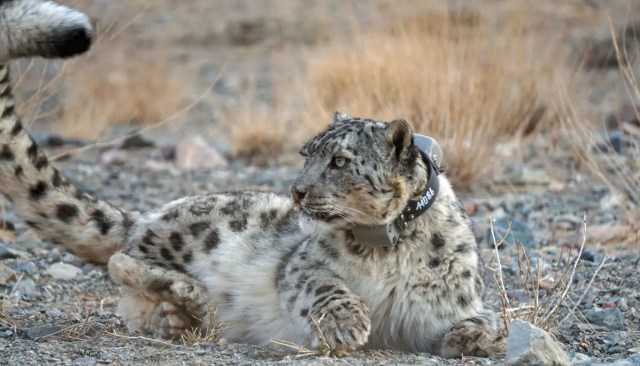One of the three cats is a large male of ca. 4-6 years of age, referred to as M15 (or “The Dude”).
M15 was collared for the first time in 2018. However, the GPS collar he was equipped with at that time suddenly stopped working this spring. Replacing it with a new collar had been one of the team’s priority goals.

The two other snow leopards collared this spring are new to the long-term study. One of them is female, referred to as F13, and the other is male, referred to as M17.
While the scientists can’t definitively determine a snow leopard’s age during collaring, they do have indicators that allow them to make an estimate.
“We think both of these new snow leopards are likely around three years old, based on their size and weight and the condition of their teeth. Since males tend to get in territorial fights quite frequently, the fact that M17 did not have a single scar on his nose also suggests he’s quite young”, says Gustaf Samelius, the Snow Leopard Trust’s Assistant Director of Science. His estimate would place the two cats’ date of birth in the early summer of 2016.
Focus on Population Dynamics
One current focus of the study is on better understanding when and how often female snow leopards have cubs, how many of these cubs typically survive, and how these parameters affect the dynamics of a population.
Unlike other big cats, snow leopards have a distinct mating season, roughly from January to March. After a gestation period of 93-110 days, cubs are usually born between May and June.
“One open question we are interested in concerns the age at which females typically give birth to their first litter of cubs. The youngest cat we’ve observed giving birth was three years old, but it seems that this isn’t always the case”, Gustaf Samelius says.

“This new female, F13, is most likely three years old, and we’re certain that she has not had cubs yet. It will be interesting to see if she gives birth this summer.”
30 Collared Cats in Total
The Snow Leopard Trust and Snow Leopard Conservation Foundation Mongolia have now collared and tracked a total of 30 individual snow leopards in the Tost Mountains over a span of ten years as part of their ongoing long-term research effort into snow leopard ecology and behavior. In total, there have been 61 captures and collarings, with several cats wearing collars multiple times.

“In addition to the GPS tracking of individual cats, we have also monitored the snow leopard populations of Tost and surrounding mountains ranges with camera traps for the last 10 years – longer than any other population in the cats’ range”, says Purevjav Lkhagvajv, the Snow Leopard Conservation Foundation’s Research and Monitoring Manager.

This is by far the world’s most comprehensive scientific study of these mysterious and elusive cats.
The study has been a team effort involving Mongolian and international researchers, Nature Reserve staff, local community rangers, students from the National University of Mongolia and even volunteers.
It has led to a number of new discoveries, including the first documented observation of wild snow leopard cubs in their den, the first documented dispersal of young adult snow leopards, and groundbreaking insights into space use, migration and reproduction cycles of these cats.

“We’re grateful to the Mongolian Ministry of Environment for supporting and facilitating our work and for granting us the permits to continue and expand this crucial research”, says Bayara Agvaantseren, Director of the Snow Leopard Conservation Foundation.
Acknowledgments
Over 70 foundations, zoos, and corporate partners, and hundreds of individual donors, have made it possible to run our long-term study and collar snow leopards over the past decade—for a full list please visit www.snowleopard.org/decade.
The Snow Leopard Trust’s long-term snow leopard study in Mongolia is in collaboration with the Snow Leopard Conservation Foundation (SLCF), the Swedish University of Agricultural Sciences (SLU), the Mongolian Ministry of Environment & Tourism, and the Mongolia Academy of Science.

